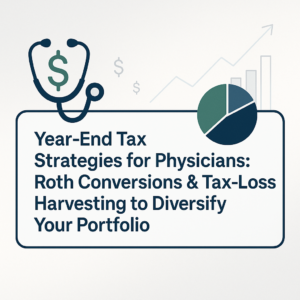Financial success isn’t just about making money; it’s about making informed decisions to help your money work for you today and in the future. For young healthcare workers — including physicians, dentists, pharmacists, physical therapists, and psychologists — juggling demanding careers and personal finances can be overwhelming. The pressure often extends from managing substantial medical school debt to navigating complex healthcare industry conditions. Comprehensive financial planning involves a strategic approach that incorporates various aspects of your finances to create an efficient plan tailored to your life goals. This guide will break down the core components of comprehensive financial planning, helping you set a path toward financial success. Let’s explore how you can navigate the unique financial challenges of the healthcare industry and build a strong foundation for your future.
What Is Comprehensive Financial Planning?
Comprehensive financial planning is a process that addresses all aspects of your financial life, from managing day-to-day expenses to planning for future needs and goals. This approach ensures your financial decisions are interconnected and aligned with your overall life aspirations. It’s not just about investing; it’s about integrating various financial concerns such as retirement, risk management, tax planning, and estate planning into a unified strategy.
The Importance of a Holistic Approach
A holistic approach means considering every aspect of your financial life rather than addressing each component in isolation. For young healthcare workers, this can involve:
- Managing student debt while starting your practice.
- Balancing work and education while planning for significant life events, like buying a home.
- Preparing for retirement early amidst a demanding career.
- Ensuring you have adequate insurance as you begin building wealth.
By taking a comprehensive view, each financial decision supports your broader objectives, making your financial life streamlined and more manageable.
Breaking Down the Components
Investment Planning
Investment planning is crucial for building wealth and achieving financial independence. Here’s how to get started:
- Identify Your Financial Goals: What are you saving for? Whether it’s retirement, a nest egg, or your children’s education, knowing your goals will shape your investment strategy.
- Understand Risk Tolerance: This refers to your ability and willingness to lose some or all of your original investment in exchange for potential higher returns. Risk tolerance is influenced by your financial situation, goals, and personality.
- Asset Allocation: Diversify your investments across different asset classes (stocks, bonds, real estate, etc.) to balance risk and reward based on your risk tolerance.
Types of Investments
To build a diversified portfolio, consider the following types of investments:
- Stocks: Provide ownership in a company and have the potential for high returns but come with higher risk.
- Bonds: Offer fixed interest payments and are generally less risky than stocks.
- Mutual Funds and ETFs: Pools of money from many investors invested in a diversified portfolio of stocks, bonds, or other assets.
- Real Estate: Can provide steady income through rental properties and potential appreciation in value.
- Alternative Investments: Includes commodities, private equity, and hedge funds, which can further diversify and potentially enhance returns.
Risk Tolerance and Asset Allocation
Understanding your risk tolerance can help you make informed decisions about asset allocation:
- Aggressive Investors: More risk-tolerant, they allocate most assets to stocks.
- Moderate Investors: Somewhat risk-tolerant, they have a balanced mix of stocks and bonds.
- Conservative Investors: Less risk-tolerant, they prefer bonds and other low-risk investments.
Practical Example of Investment Planning
Hypothetical: Dr. Smith, a young dentist, aims to retire early by age 55. She allocates 80% of her portfolio to aggressive growth stocks, 10% to bonds for stability, and 10% to alternative investments like real estate to diversify her income sources. Every year, she reviews her portfolio and rebalances it to match any changes in her risk tolerance and market performance.
Risk Management and Insurance Planning
As a healthcare professional, managing risk through insurance is essential. Here are the types of insurance you should consider:
- Life Insurance: Provides financial security to your dependents in case of your untimely death.
- Disability Insurance: Protects against unlikely, but financially critical, circumstances that cause a long term disability.
- Health Insurance: Covers medical expenses and is crucial given the rising healthcare costs.
- Property Insurance: Protects significant assets, like your home, from damage or loss.
- Liability Insurance: Offers protection against potential lawsuits, which can be particularly relevant for healthcare professionals.
Choosing the Right Insurance Policies
When selecting insurance, consider:
- Coverage Amounts: Ensure you have sufficient coverage to replace your income and protect your assets.
- Policy Terms: Understand the terms and conditions, including any exclusions.
- Premium Costs: Compare premiums and ensure they fit within your budget.
Potential Impact of Underinsurance
Underinsurance can leave you vulnerable to significant financial losses. Ensure your coverage is comprehensive enough to cover unexpected situations without depleting your savings.
Practical Example of Insurance Planning
Hypothetical: Dr. Lee, a young surgeon, realizes the importance of disability insurance. He consults with an insurance advisor and opts for a policy that covers 60% of his income in case of a disability. Additionally, he invests in a robust malpractice insurance plan to protect himself from potential lawsuits.
Retirement Planning
Starting retirement planning early in your career can yield significant benefits due to the power of compounding. Healthcare professionals often have delayed earnings due to extended education and training periods, making it even more crucial to start early once you begin earning.
Here’s a breakdown of tools that can help in planning for retirement:
- 401(k)/403(b) Plans: Employer-sponsored retirement plans. Check if your employer offers a match.
- Individual Retirement Accounts (IRAs): Traditional IRAs offer tax-deferred growth, while Roth IRAs offer tax-free growth.
- SEP IRAs/SIMPLE IRAs: Retirement plans for self-employed individuals or small business owners.
- Annuities: Provide a steady income stream during retirement.
Maximizing Retirement Savings
- Employer Contributions: Take full advantage of any employer matching contributions.
- Automatic Contributions: Set up automatic transfers to your retirement accounts to ensure consistent savings.
- Annual Increases: Increase your contribution rate annually to boost your retirement savings.
Retirement Planning Strategies
- Diversify Retirement Accounts: Spread your savings across various accounts to optimize tax benefits and access.
- Consideration of Future Health Expenses: Factor in potential healthcare costs, as they can significantly impact your retirement savings.
Practical Example of Retirement Planning
Hypothetical: Dr. Kim, a pharmacist, starts contributing to her 401(k) immediately upon starting her job. She ensures she contributes enough to receive her employer’s full match. Over the years, she increases her contributions annually. By leveraging employer contributions and the growth potential of her investments, she builds a substantial retirement nest egg by her late 50s.
Tax Planning
Proper tax planning can help reduce your tax burden, freeing up more funds for investments and savings:
- Maximize Retirement Contributions: Contributing to retirement plans can provide significant tax benefits.
- Utilize Tax-Advantaged Accounts: Accounts like HSAs (Health Savings Accounts) offer tax deductions and tax-free growth.
- Understand Deductions and Credits: Be aware of potential tax deductions (like student loan interest) and credits that you may be eligible for.
- Plan Asset Sales Strategically: Be mindful of capital gains tax, and consider timing your asset sales to minimize tax impact.
Tax-Advantaged Accounts
- Health Savings Accounts (HSAs): Offer triple tax benefits — deductible contributions, tax-free growth, and tax-free withdrawals for eligible medical expenses.
- Flexible Spending Accounts (FSAs): Allow you to set aside pre-tax dollars for qualified medical expenses.
- 529 College Savings Plans: Allows tax-free growth and withdrawals for qualified educational expenses, which can be beneficial if you have or plan to have children.
Practical Example of Tax Planning
Hypothetical: Dr. Johnson, a young psychologist, takes full advantage of tax-advantaged accounts. He contributes to an HSA, which grows tax-free and covers his healthcare expenses. Moreover, he deducts his student loan interest and education-related expenses, significantly reducing his taxable income each year.
Estate Planning
Estate planning is essential to ensure that your assets are distributed according to your wishes:
- Wills: Legal documents that specify how your assets should be distributed after your death.
- Trusts: Provide more control over asset distribution and can help avoid probate.
Estate planning involves:
- Creating a Will: Specifies your wishes regarding asset distribution.
- Establishing Trusts: Helps manage assets and protect them from legal issues.
- Designating Beneficiaries: Ensures your retirement accounts and life insurance benefits go to your chosen individuals.
- Power of Attorney and Healthcare Directives: Designates individuals to make financial and healthcare decisions on your behalf if you are unable.
Practical Example of Estate Planning
Hypothetical: Dr. Martinez, a physical therapist, establishes a living trust to manage her assets while she’s alive and to avoid probate after her death. She also sets up a healthcare directive specifying her medical treatment preferences and appoints a power of attorney to make financial decisions on her behalf if she becomes incapacitated.
The Role of A CERTIFIED FINANCIAL PLANNER™
A CERTIFIED FINANCIAL PLANNER™ can provide valuable insights and tailored advice, helping you align your financial strategies with your life goals:
- Objective Advice: Advisors provide an unbiased perspective.
- Expertise: They possess advanced knowledge in financial products and strategies.
- Customized Planning: Advisors can create personalized plans that consider your unique financial situation and goals.
- Ongoing Support: Regular check-ins can help adjust your financial plan as your life circumstances change.
Choosing the Right Financial Advisor
- Credentials and Experience: Look for advisors with relevant credentials (e.g., CFP®) and experience working with healthcare professionals.
- Fee Structure: Understand how your advisor is compensated (fee-only vs. commission-based) to avoid potential conflicts of interest.
- Personal Fit: Ensure you feel comfortable with your advisor’s communication style and approach.
Evaluating Financial Advisors
- Interview Multiple Advisors: Speak with several advisors to find the best fit for your needs.
- Check References: Ask for and check references from other clients, particularly healthcare professionals.
- Review Performance: Regularly review the performance of your investments and the advisor’s recommendations.
Practical Example of Using a Financial Advisor
Hypothetical: Dr. Blake, a young surgeon, enlists the help of a CERTIFIED FINANCIAL PLANNER™(CFP®) to manage his investments, retirement planning, and tax strategies. He feels confident in his advisor’s expertise and appreciates the customized advice tailored to his specific goals and situation. Over the years, regular check-ins ensure that his financial plan remains aligned with his evolving life circumstances.
Creating Your Financial Plan
1. Setting Financial Goals
- Short-term goals might include paying off student loans or saving for a down payment on a home.
- Long-term goals could involve retirement planning or establishing a trust fund.
2. Tracking Finances and Assessing the Current Financial State
- Build a budget that tracks income, expenses, and savings. Use tools like budgeting apps to simplify the process.
- Assess your current financial health by calculating your net worth and analyzing your cash flow.
3. Developing a Strategy for Achieving Financial Goals
- Prioritize your goals based on urgency and importance.
- Develop actionable steps for each goal, such as setting up automated savings or diversifying investments.
4. Implementing and Monitoring the Plan
- Execute your financial strategies and make adjustments as necessary.
- Regularly review your plan to ensure it remains aligned with your goals and any changes in your financial situation.
Common Financial Pitfalls to Avoid
- Underestimating Expenses: Make sure to budget for all recurring and unexpected expenses.
- Overlooking Insurance Needs: Ensure you have adequate coverage to protect against potential risks.
- Ignoring Debt Repayment: Develop a strategy to tackle high-interest debt to avoid it detracting from your savings goals.
Adjusting Your Plan Over Time
Financial planning is not a one-time event. It evolves with your life circumstances:
- Life Changes: Marriage, having children, career advancements, and other milestones may necessitate revising your financial plan.
- Market Changes: Economic shifts can impact investment performance and risk strategies.
- Legislative Changes: Alterations in tax laws and financial regulations may require updates to your plan.
The Importance of Reviewing and Adjusting Your Financial Plan Periodically
Reviewing your plan at least annually helps ensure it stays on track:
- Rebalance Investments: Ensure your asset allocation aligns with any changes in your risk tolerance or financial goals.
- Update Beneficiaries: Review and update beneficiary designations regularly.
- Adjust Contributions: Increase savings or investment contributions as your income grows.
- Seek Professional Reviews: Schedule periodic reviews with a financial advisor to get expert advice on potential adjustments.
Handling Unforeseen Financial Challenges
Life is full of surprises, and your financial plan should be flexible enough to handle unexpected events:
- Emergency Fund: Maintain an emergency fund to cover at least 3-6 months of living expenses.
- Reevaluate Spending: Adjust discretionary spending if you face a financial setback.
- Revisit Goals: Modify your financial goals if necessary to align with new circumstances.
Conclusion
Comprehensive financial planning is essential for long-term financial health and achieving life goals. By addressing all aspects of your financial life, you can create a robust plan that not only meets your financial needs but also adapts to changes over time. Embrace a holistic financial approach and seek professional advice to navigate your financial journey successfully.
This guide aims to provide you with an in-depth understanding of the crucial elements of comprehensive financial planning. Implementing these strategies can help you take charge of your financial health, allowing you to focus on your career and personal life with confidence.
Remember, the information provided here is for educational purposes only and should not be considered as a substitute for professional financial advice. To tailor a financial plan specific to your needs, consulting with a CERTIFIED FINANCIAL PLANNER™ is highly recommended.
By incorporating the wealth of financial planning strategies outlined in this guide, you can build a strong foundation for your financial future. Whether you are just starting your career in healthcare or have been practicing for years, adopting a comprehensive financial plan can help you achieve the financial success you aspire to.






